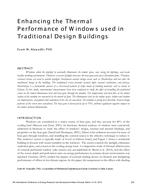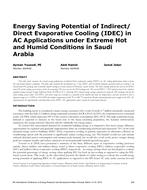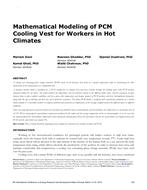-
-
Available Formats
- Options
- Availability
- Priced From ( in USD )
-
Available Formats
-
- Immediate download
- $16.00
- Add to Cart
Customers Who Bought This Also Bought
-

ICER16-27 -- Enhancing the Thermal Performance of Windows...
Priced From $16.00 -

ICER16-25 -- Modeling of Condensation Film Thickness and ...
Priced From $16.00 -

ICER16-34 -- Energy Saving Potential of Indirect/Direct E...
Priced From $16.00 -

ICER16-17 -- Mathematical Modeling of PCM Cooling Vest fo...
Priced From $16.00
About This Item
Full Description
The main objective of this paper is to investigate a water-based non-vapor compression cooling system and evaluate the temperature drop and potential cooling effect due to cavitation of an arbitrary liquid. Water as a working fluid has the advantages of being inexpensive and environmentally safe for use, as compared to commercially available chemical refrigerants. The water-based cooling system investigation employed cavitation phenomena in converging-diverging glass nozzles. Cavitation results from a pressure decrease into the metastable liquid region, to the point where some of the liquid nucleates (boils). Cavitation can be in the form of traveling bubble cavitation, vortex cavitation, cloud cavitation, or attached wall cavitation. Under adiabatic conditions, the energy required to produce this phase change is pulled from the fluid itself, which results in a temperature drop. The paper focuses on visualizing cavitation for water flowing through converging- diverging glass nozzles. These nozzles had throat diameters between 2 mm and 4 mm. A high-speed camera was used to record videos and images of the associated cavitation phenomena. The second part of the paper discusses the fundamental thermodynamics associated with the temperature drop in an effort to better understand the cooling process and to identify of the optimum fluid capable of developing significant cooling results. A basic theory was then formulated to determine the maximum temperature reduction. ΔTmax, which will occur if the cavitation phase transition occurs adiabatically. Variables that affect this maximum temperature drop are identified and shown to include latent heat of vaporization, specific heat, and "equivalent quality" at the spinodal line limit. Further analysis of the temperature drop as a function of reduced pressure was investigated for water, R134a, R123, and R22, and reveals that an apparent optimum (or maximum) temperature drop is achieved for a general fluid when the reduced pressure equals approximately 0.5.





